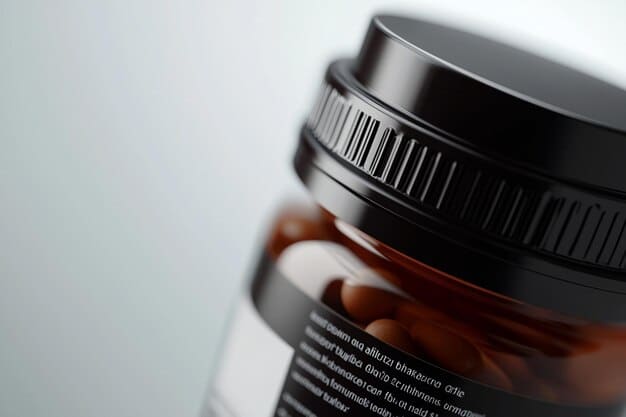Is Your Pre-Workout Safe? A 2025 Analysis of Top Brands

Navigating the safety of pre-workout supplements in 2025 requires a critical look at ingredient transparency, brand reputation, and individual physiological responses to ensure effective and secure athletic enhancement.
In the dynamic world of fitness, pre-workout supplements have become a staple for many seeking an extra edge in their training. But with an ever-evolving market, a crucial question arises: Is Your Pre-Workout Supplement Safe? A 2025 Analysis of Top Brands delves into the complexities of these popular products, examining their ingredients, efficacy, and potential risks to help you make informed decisions about what you put into your body.
Understanding the Mechanics of Pre-Workout Supplements
Pre-workout supplements are designed to boost energy, enhance focus, and improve athletic performance during exercise. They typically contain a blend of ingredients, each serving a specific purpose to optimize physiological functions. However, the precise combination and dosage of these ingredients can significantly impact both their effectiveness and safety profile. As we move into 2025, the industry sees continued innovation alongside persistent concerns about transparency and regulation.
Common Ingredients and Their Roles
Many pre-workout formulas share a core set of ingredients known for their performance-enhancing properties. These components work synergistically to prime the body for intense physical activity. Understanding their individual functions is key to appreciating the overall effect of a supplement. Some ingredients act as stimulants, while others support muscle function or nutrient delivery.
- Caffeine: A central nervous system stimulant, caffeine is widely used for its ability to increase alertness, reduce fatigue, and improve exercise performance.
- Creatine Monohydrate: Known to enhance strength and power output by increasing the availability of ATP, the body’s primary energy currency.
- Beta-Alanine: Boosts muscle carnosine levels, which helps buffer lactic acid, delaying muscle fatigue and improving endurance.
- L-Citrulline/Citrulline Malate: An amino acid that converts to L-arginine in the body, promoting nitric oxide production, which enhances blood flow to muscles.
- Branched-Chain Amino Acids (BCAAs): Leucine, isoleucine, and valine are essential for muscle protein synthesis and can help reduce muscle breakdown during exercise.
Synergy and Potential Interactions
While individual ingredients have known benefits, their combined effect within a pre-workout blend can be complex. Manufacturers aim for synergistic formulations where ingredients amplify each other’s benefits, but this also introduces potential for interactions that might not be fully understood. Research continues to evolve on how different compounds interact within the human body, particularly under the stress of high-intensity exercise. Consumers are becoming more aware of potential interactions and are seeking products that prioritize scientific backing over proprietary blends.
The mechanics of how these supplements work involve intricate pathways within the body. For instance, enhanced blood flow from L-citrulline can improve nutrient delivery, while caffeine sharpens neurological responses. This multi-faceted approach is what gives pre-workouts their appeal, promising a comprehensive boost across various aspects of physical performance. However, this complexity also underscores the need for careful ingredient selection and dosage.
Regulatory Landscape in 2025: What’s Changed?
The regulatory environment for pre-workout supplements is a critical factor influencing their safety and consumer trust. Unlike pharmaceuticals, dietary supplements in the United States, including pre-workouts, are largely regulated post-market by the Food and Drug Administration (FDA). This means manufacturers are primarily responsible for ensuring their products’ safety and labeling accuracy before they hit the shelves. As we look at 2025, calls for more stringent pre-market evaluation continue to grow louder, driven by past incidents involving undisclosed or harmful ingredients.
Significant strides have been made in certain areas, particularly regarding ingredient transparency. Many reputable brands are now adopting third-party testing and certification programs to validate their products’ purity and potency, a trend that has accelerated in recent years. This voluntary adoption of higher standards helps bridge the gap where governmental regulations might be perceived as insufficient. Consumer demand for clean labels and verified products is a powerful driver for these industry shifts.
FDA Oversight and Enforcement Priorities
The FDA’s primary role includes monitoring adverse event reports, investigating product complaints, and taking action against companies that market adulterated or misbranded supplements. In 2025, the agency has emphasized a proactive approach to potential contaminants and undeclared ingredients, especially those with drug-like effects. However, the sheer volume of products on the market makes comprehensive oversight challenging.
The FDA focuses on several key areas:
- Undeclared Ingredients: Identifying and removing products that contain hidden pharmaceutical ingredients or prohibited substances like synthetic stimulants.
- Misleading Claims: Ensuring product labels do not make false or unsubstantiated health claims.
- Good Manufacturing Practices (GMPs): Verifying that manufacturers adhere to quality control standards to prevent contamination and ensure consistent product quality.
Industry Self-Regulation and Third-Party Certifications
In response to regulatory gaps and increasing consumer skepticism, the supplement industry has seen a rise in self-regulatory initiatives. Organizations like NSF International, Informed-Sport, and USP offer certification programs that rigorously test products for contaminants, banned substances, and label accuracy. Products bearing these seals provide an added layer of assurance for consumers. This trend is expected to strengthen in 2025 as brands compete on trust and transparency.
These certifications provide a vital benchmark for safety and quality. They signify that a product has undergone independent verification, going beyond the minimum regulatory requirements. For consumers researching “Is Your Pre-Workout Supplement Safe? A 2025 Analysis of Top Brands,” these certifications are often considered a strong indicator of product reliability and ethical manufacturing practices.
Top Brands in 2025: A Safety Deep Dive
Analyzing the safety of top pre-workout brands in 2025 requires a multi-faceted approach, looking beyond marketing claims to the core of their product integrity. Transparency in ingredient listing, adherence to good manufacturing practices (GMPs), and responsiveness to consumer feedback are hallmarks of brands that prioritize safety. This section examines brands that have consistently demonstrated a commitment to producing reliable and effective supplements, considering their ingredient choices, third-party testing, and overall industry reputation.
Brand A: Transparency and Ingredient Sourcing
Brand A has built a strong reputation on its commitment to transparency. Their product labels are meticulously detailed, often listing dosages of active ingredients rather than proprietary blends. They frequently disclose their sourcing partners and provide certificates of analysis for their raw materials, allowing consumers to verify purity and potency. This level of openness is increasingly valued by consumers in 2025 and sets a high bar for the industry.

Their popular pre-workout formula, “EnergizeMax,” exemplifies this approach. It features well-researched ingredients like L-Citrulline Malate at efficacious doses, alongside naturally sourced caffeine and nootropic compounds. Consumer reports often praise the clean energy and focus provided, with minimal jitters, suggesting a carefully balanced formulation. This brand actively engages with scientific research, often reformulating products based on new findings.
Brand B: Focus on Third-Party Testing and Certification
Brand B distinguishes itself through its rigorous third-party testing protocols. Every batch of their pre-workout, “PowerPulse,” undergoes independent laboratory analysis for banned substances, heavy metals, and microbial contaminants. They proudly display certifications from organizations like Informed-Sport, making their products a preferred choice for athletes subject to doping controls. This stringent testing eliminates much of the guesswork regarding product purity and safety.
While not always using fully transparent labels (some products still utilize proprietary blends), their commitment to comprehensive third-party verification provides a strong safety net. Consumers trust their products because the certifications offer irrefutable proof of what’s inside and what’s not. This brand also maintains a robust customer service channel, quickly addressing any concerns and showcasing a commitment to post-purchase satisfaction. Their continued presence at the top of “Is Your Pre-Workout Supplement Safe? A 2025 Analysis of Top Brands” lists is largely due to this unwavering dedication to verified quality.
Brand C: Innovation with Holistic Performance
Brand C, “PeakPerformance Labs,” has gained traction in 2025 by focusing on advanced, often novel, ingredients aimed at holistic performance rather than just raw stimulation. Their flagship pre-workout, “SynapseFuel,” incorporates adaptogens, nootropics, and unique nutrient delivery systems alongside traditional stimulants. They emphasize a balanced energy profile designed to support sustained effort and cognitive function without excessive reliance on caffeine.
Their safety approach involves meticulous quality control at every stage of manufacturing, aiming for pharmaceutical-grade purity in their compounds. While their ingredient lists can be complex due to the innovative nature of their formulations, they provide extensive scientific literature and white papers to back their claims. This brand appeals to a sophisticated consumer base that values cutting-edge science and a more nuanced approach to pre-workout supplementation. They are actively involved in scientific research partnerships, contributing to the broader understanding of exercise physiology and nutrition.
Navigating Potential Risks and Side Effects
Despite their popularity, pre-workout supplements are not without potential risks and side effects. Understanding these can help consumers make an informed choice and avoid adverse reactions. The severity and type of side effects often depend on the individual’s sensitivity to certain ingredients, particularly stimulants, and the dosage consumed. In 2025, there’s a heightened awareness of tailoring supplement intake to individual tolerance.
Stimulant Overload and Cardiovascular Concerns
The most common concern with pre-workouts stems from their stimulant content, primarily caffeine. Excessive caffeine intake can lead to jitters, anxiety, increased heart rate, and elevated blood pressure. For individuals with pre-existing heart conditions or high blood pressure, this can pose significant health risks. It’s crucial to assess personal caffeine tolerance and avoid combining pre-workouts with other caffeine sources throughout the day.
Symptoms of stimulant overload include:
- Nervousness or anxiety
- Heart palpitations or rapid heartbeat
- Insomnia or disturbed sleep patterns
- Digestive upset, such as nausea or diarrhea
- Headaches or dizziness
Digestive Issues and Skin Sensations
Ingredients like beta-alanine, while beneficial for performance, can cause a harmless tingling sensation known as paresthesia. While generally considered benign, some individuals find this uncomfortable. Other ingredients or their combination can lead to digestive distress, including bloating, gas, or stomach cramps. These issues are often transient but can be disruptive to a workout.
Potential Drug Interactions and Undisclosed Ingredients
A more serious risk lies in potential interactions with medications or the presence of undisclosed ingredients. Some pre-workouts have been found to contain banned substances or pharmaceutical compounds not listed on the label, which can have severe health consequences and lead to positive drug tests for athletes. Always consult a healthcare professional before starting any new supplement, especially if you are on medication. The “Is Your Pre-Workout Supplement Safe? A 2025 Analysis of Top Brands” imperative stresses the importance of purchasing from reputable sources that provide comprehensive third-party testing results. Brands that prioritize this transparency mitigate these risks significantly.
Best Practices for Safe Pre-Workout Use in 2025
Ensuring the safe and effective use of pre-workout supplements involves more than just picking a reputable brand; it requires a mindful approach to dosage, timing, and personal health. As we enter 2025, consumer education on responsible supplementation has become paramount, emphasizing that these products are aids, not substitutes, for sound nutrition and training principles.
Start Low, Go Slow
A fundamental principle for any new supplement is to begin with a lower dose than recommended to assess your tolerance. This allows your body to adapt and helps identify any adverse reactions before committing to a full dose. Many pre-workout formulas are highly concentrated, and individual responses can vary significantly based on factors like body weight, caffeine sensitivity, and overall health. If you are questioning “Is Your Pre-Workout Supplement Safe? A 2025 Analysis of Top Brands,” starting with half a scoop is a simple, effective safety measure.
Timing and Hydration are Key
Pre-workouts should typically be consumed 20-30 minutes before exercise to allow ingredients time to be absorbed and activate. Avoid taking them too close to bedtime, especially if they contain stimulants, to prevent sleep disturbances. Adequate hydration is also crucial, as many ingredients can be diuretics or require sufficient water for optimal absorption and function. Dehydration can exacerbate potential side effects and hinder performance.
Cycle On and Off
To maintain effectiveness and reduce the risk of building tolerance or dependency, it’s advisable to cycle pre-workout use. This means taking breaks from the supplement, perhaps using it only on specific training days or for limited periods. A common strategy is to use it for 6-8 weeks, followed by a 2-4 week break. This cycling can help maximize the supplement’s impact when you do use it and gives your body a chance to reset.
Consult a Healthcare Professional
Before integrating any new supplement into your routine, particularly if you have pre-existing health conditions, are pregnant or nursing, or are taking medications, consult with a doctor or a registered dietitian. They can provide personalized advice based on your health status and help identify potential interactions or contraindications. This professional guidance ensures that your pursuit of enhanced performance doesn’t compromise your well-being.

Prioritize a Quality Lifestyle
Ultimately, no supplement can compensate for poor nutrition, inadequate sleep, or inconsistent training. Pre-workouts are designed to complement a healthy lifestyle, not replace it. Focusing on whole foods, getting sufficient rest, and adhering to a well-structured exercise program will always form the bedrock of sustainable fitness and performance. Supplements should be viewed as tools to optimize an already solid foundation, aligning with the core message of “Is Your Pre-Workout Supplement Safe? A 2025 Analysis of Top Brands.”
The Future of Pre-Workouts: Trends to Watch in 2025 and Beyond
The landscape of pre-workout supplements is continually evolving, driven by scientific advancements, changing consumer preferences, and enhanced regulatory scrutiny. As we navigate through 2025, several key trends are emerging that will shape the future of these performance aids, focusing increasingly on personalized nutrition, sustainable sourcing, and cognitive enhancement.
Personalized Nutrition and Genetic Testing Integration
One of the most significant trends is the move towards personalized pre-workout formulations. Advances in genetic testing and wearable technology allow for a more precise understanding of an individual’s unique physiological responses to ingredients like caffeine or creatine. In the future, consumers may receive custom blends tailored to their genetic predispositions, exercise goals, and even daily energy fluctuations. This bespoke approach aims to optimize efficacy while minimizing potential side effects, moving beyond the traditional one-size-fits-all model.
Emphasis on Natural and Sustainable Ingredients
There’s a growing demand for pre-workouts that utilize natural, ethically sourced, and sustainable ingredients. Consumers are increasingly scrutinizing not just what’s in their supplements, but where it comes from and how it’s produced. This trend is leading to more plant-based formulations, organic certifications, and brands highlighting their environmental responsibility. The focus is shifting towards “clean” pre-workouts that are free from artificial sweeteners, colors, and obscure chemicals, aligning with a broader wellness movement.
Future innovations might involve:
- Fermented ingredients for improved bioavailability.
- Upcycled ingredients from food production.
- Traceable supply chains for enhanced transparency.
Nootropic Integration for Mental Clarity and Focus
Beyond sheer physical energy, the next generation of pre-workouts will likely place a greater emphasis on cognitive enhancement. While some current formulas include basic nootropics (brain-boosting ingredients), future products are expected to deploy more sophisticated blends designed to sharpen focus, improve reaction time, and reduce mental fatigue during workouts. This trend recognizes the integral connection between mental and physical performance, aiming to optimize both simultaneously for a more holistic training experience. This focus on cognitive benefits will be a crucial aspect when considering “Is Your Pre-Workout Supplement Safe? A 2025 Analysis of Top Brands” in coming years.
Augmented Transparency and Blockchain Technology
To further combat concerns about undisclosed ingredients and mislabeling, brands may increasingly leverage technologies like blockchain to provide immutable records of their supply chain—from raw material sourcing to manufacturing and third-party testing. This level of transparency would allow consumers to verify every step of a product’s journey, building unprecedented levels of trust. Digital proofs of authenticity and detailed product histories could become standard, offering ultimate peace of mind.
These trends signify a maturing market for pre-workout supplements, one that is becoming more sophisticated, consumer-centric, and scientifically driven. The future promises products that are not only more effective but also safer and more aligned with individual health and ethical values.
| Key Point | Brief Description |
|---|---|
| 🌱 Ingredient Transparency | Top brands in 2025 prioritize clear labeling and disclose ingredient dosages, moving away from proprietary blends for enhanced user trust. |
| 🔬 Third-Party Testing | Certification from independent labs (e.g., Informed-Sport) is crucial for verifying purity and absence of banned substances. |
| ⚠️ Read Labels & Assess Tolerance | Always check ingredient lists for allergens/sensitivities and start with a low dose to gauge individual reaction. |
| 🧑⚕️ Consult a Professional | Seek medical advice before use, especially if you have chronic conditions or are on medication. |
Frequently Asked Questions About Pre-Workout Safety
Most pre-workout supplements are not recommended for individuals under the age of 18, primarily due to their stimulant content and the lack of research on their long-term effects on adolescent development. Younger individuals should prioritize a balanced diet, proper hydration, and consistent training before considering supplementation.
To minimize the risk of consuming banned substances, look for pre-workout supplements that are third-party tested and certified by organizations like Informed-Sport, NSF Certified for Sport, or USP. These certifications indicate that the product has been screened for a wide range of prohibited compounds and its ingredients verified.
When used appropriately by healthy individuals, pre-workouts are generally not associated with long-term health issues. However, chronic overuse, especially of high-stimulant formulas, could potentially lead to issues like increased anxiety, sleep disturbances, or strain on the cardiovascular system. Always adhere to recommended dosages and consult a healthcare professional.
It’s generally not recommended to take pre-workout every single day. Daily use can lead to tolerance buildup, diminished effects, and potential reliance on stimulants. Cycling on and off the supplement allows your body to reset and helps maintain its effectiveness. Prioritize natural energy from sleep and nutrition on rest days.
If you experience severe adverse side effects like chest pain, extreme jitters, dizziness, or difficulty breathing, discontinue use immediately and seek medical attention. For milder symptoms like nausea or mild jitters, reduce your dosage or stop using the product. Always inform your healthcare provider about any supplements you are taking.
Conclusion
As we’ve explored in this 2025 analysis, the question of “Is Your Pre-Workout Supplement Safe?” is multifaceted, hinging on factors ranging from ingredient transparency and regulatory oversight to individual physiological responses. The landscape for these performance aids is continually evolving, with a clear trend towards greater brand accountability through third-party testing and a consumer demand for natural, effective, and fully disclosed formulations. While pre-workouts can be valuable tools for enhancing training, their safe use necessitates an educated approach. By understanding common ingredients, recognizing potential risks, and adhering to best practices like starting with low doses and consulting health professionals, individuals can confidently navigate the market. Ultimately, responsible supplementation, coupled with a foundation of good nutrition and consistent training, remains the key to optimizing both performance and well-being.





